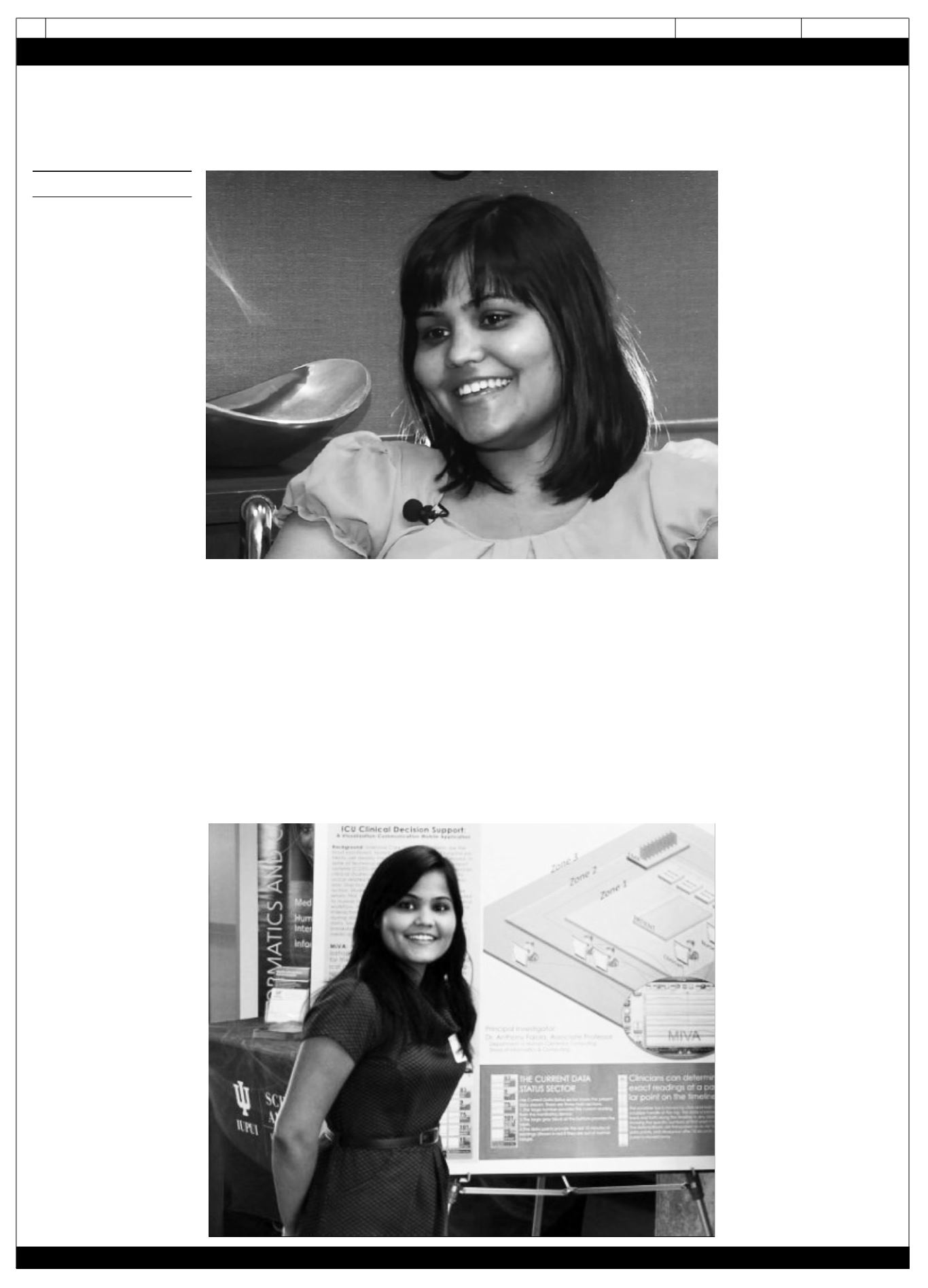
News India Times
May 1, 2015
12
Cover Story
ByMichael E. Miller
omething was wrong
withYamini Karanam.
The PhD student
had moved from
Hyderabad, India, to
Indianapolis to study
computer science. But her new
life in America was amiss. Once
a brilliant student, she now had
trouble understanding simple
articles. Friends and colleagues
would say things to her, only for
the sentences to get mixed up in
her mind.
Because that’s where
Karanam’s problem lay: deep
within her brain.
She went on holiday last fall
but returned even more
exhausted than when she left.
Karanam slept for two weeks
straight, missing school.
“Then came the headaches.
Slips and misses at work fol-
lowed,” she wrote on her blog.
“There were doctors. First, a
couple of them and then more.”
Then came the “revelation”:
Doctors spotted what they
thought was a cyst on Karanam’s
pineal gland, a tiny pea-like
structure in the center of the
brain that French philosopher
René Descartes called the “prin-
cipal seat of the soul.”
“The fear didn’t sink in yet,”
Karanamwrote. “[My] will was
undeterred because it was hard-
ly put to test. [My] energy levels
were sinking and fatigue started
crippling [my] days. …Months
and weeks slipped through [my]
fingers. There weren’t any diag-
nostic procedures left to run on
[me]. Consultations followed
procedures but nobody said
anything useful. It was like white
noise passed from the doctor to
the patient to the support sys-
tem. Now, they called it a tumor
and that’s all 21st century medi-
cine could do in three months.”
Karanam grew sicker and
sicker as the tumor grew larger
and larger. Reading was impos-
sible. Soon, walking was, too.
Only 26 years old, Karanam
could barely eat. Pains ran from
her head throughout her body.
“But the men of science
found no correlation between
her suffering and the images,”
she wrote.
“[I] thought they would take
[my] problems and own them.
But they don’t and they didn’t.
There was frustration and anger.
Most of all, there was self-doubt.
When sanity is in question, the
best of us lose ourselves to the
answer.”
Desperate to save Karanam’s
life, her friends set up a
fundraising account online.
“Yamini, a PhD student at
Indiana University’s School of
Informatics and one of my best
friends, was diagnosed with a
pineal tumor a fewmonths ago,”
the website read.
“She has been seeing quite a
few neurologists and neurosur-
geons across the country in the
past six months. Most of the
doctors seem to think that the
location of the tumor poses a lot
of risks to the surgery and they
think that the tumor could cause
irreversible damage to her
brain.”
“Could you please put an end
to it one way or the other?”
Karanam finally wrote to some-
one – God, doctors, anyone – on
March 15.
Then came the medical pro-
cedure – a miracle by another
name, really – that would save
Karanam’s life and reveal the
bizarre malady behind her melt-
down.
Karanam found a doctor,
Hrayr Shahinian, performing
radical “keyhole” brain surgeries
at something called the
Skullbase Institute in Los
Angeles.
Using the $32,437 her friends
had raised for her, Karanam flew
out to L.A. and put her life in
Shahinian’s hands.
Shahinian made a tiny inci-
sion in the back of Karanam’s
head, then strung an endoscope
into her skull and through a nat-
ural channel in her brain to the
site of the tumor. That’s when
the doctor made a startling dis-
covery.
Karanam’s tumor wasn’t just a
tumor. It was a teratoma: a
clump of bone, hair and teeth. A
Frankenstein’s monster within
Karanam’s own mind.
Teratomas have baffled scien-
tists for almost a century. Some
have speculated that they are
basically twins that never quite
develop and are instead
absorbed into the surviving
baby’s body.
In fact, newborns occasional-
ly have large teratomas attached
to them like a conjoined twin.
Other times, it’s not until adult-
hood that people realize they
have one. In 2009, a British man
named Gavin Hyatt “gave birth”
to an “undeveloped identical
twin” when a small lump
pushed its way out of his
abdomen. Hyatt named the tiny
creature “little Gav.” Earlier this
year, doctors in Hong Kong dis-
covered two partially developed
fetuses inside a newborn’s
abdomen. It’s not clear whether
Karanam’s tumor was really her
twin. But it was killing her.
Shahinian successfully removed
the tumor, which was not can-
cerous. He now expects
Karanam to make a full recovery.
“This is my second one,” he
said of the intracranial teratoma,
“and I’ve probably taken out
7,000 or 8,000 brain tumors.”
When Karanam awoke in the
hospital, she was stunned to
learn that her tumor wasn’t just
a lump of cells, but her “evil twin
sister who’s been torturing me
for the past 26 years,” she told
NBC 4.
Physically, Karanam should
be back to normal in three
weeks. But her near brush with
death at the hands of her own
“twin” has clearly affected her.
Her blog is titled, “The ‘n’ Phases
of her Tumor,” which is basically
a math joke about her ordeal. It
features a blue cloud with a smi-
ley face that could be easily con-
fused for the tumor she had
removed.
“It’s more of a happy brain!”
Karanam tells TheWashington
Post. But she admits that her
experience has left her with a
strange connection to her twin.
“I was stuck with it much longer
than I thought,” she says. “It
doesn’t leave you much choice
other than to deal with it the
best you can.”
– TheWashington Post
– that’s all you need to know
S
Karanam grew
sicker and sicker as
the tumor grew
larger and larger.
Reading was
impossible. Soon,
walking was, too.
Only 26 years old,
Karanam could
barely eat.
Pains ran from her
head throughout
her body
Yamini
Karanam’s
‘Evil Twin’


